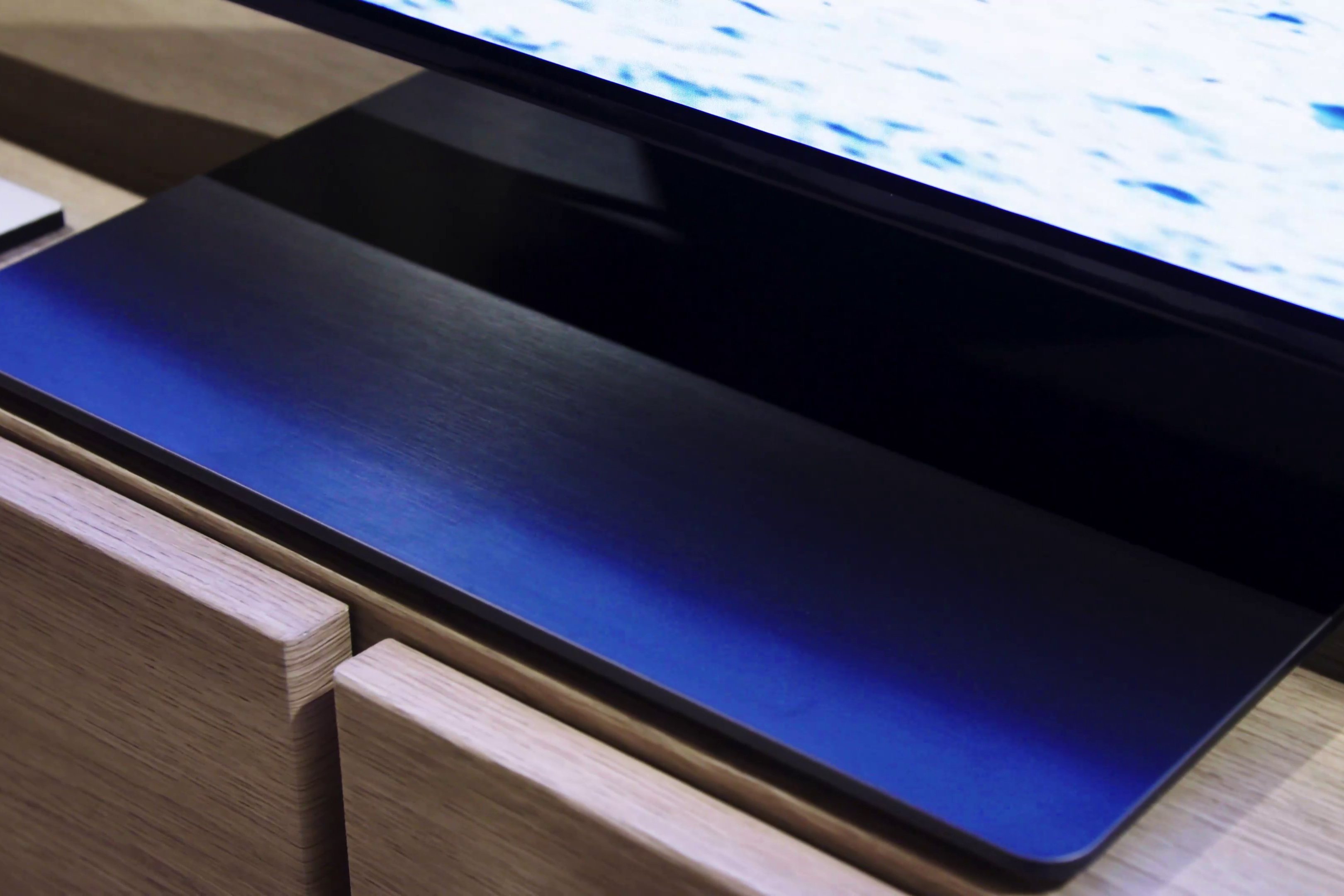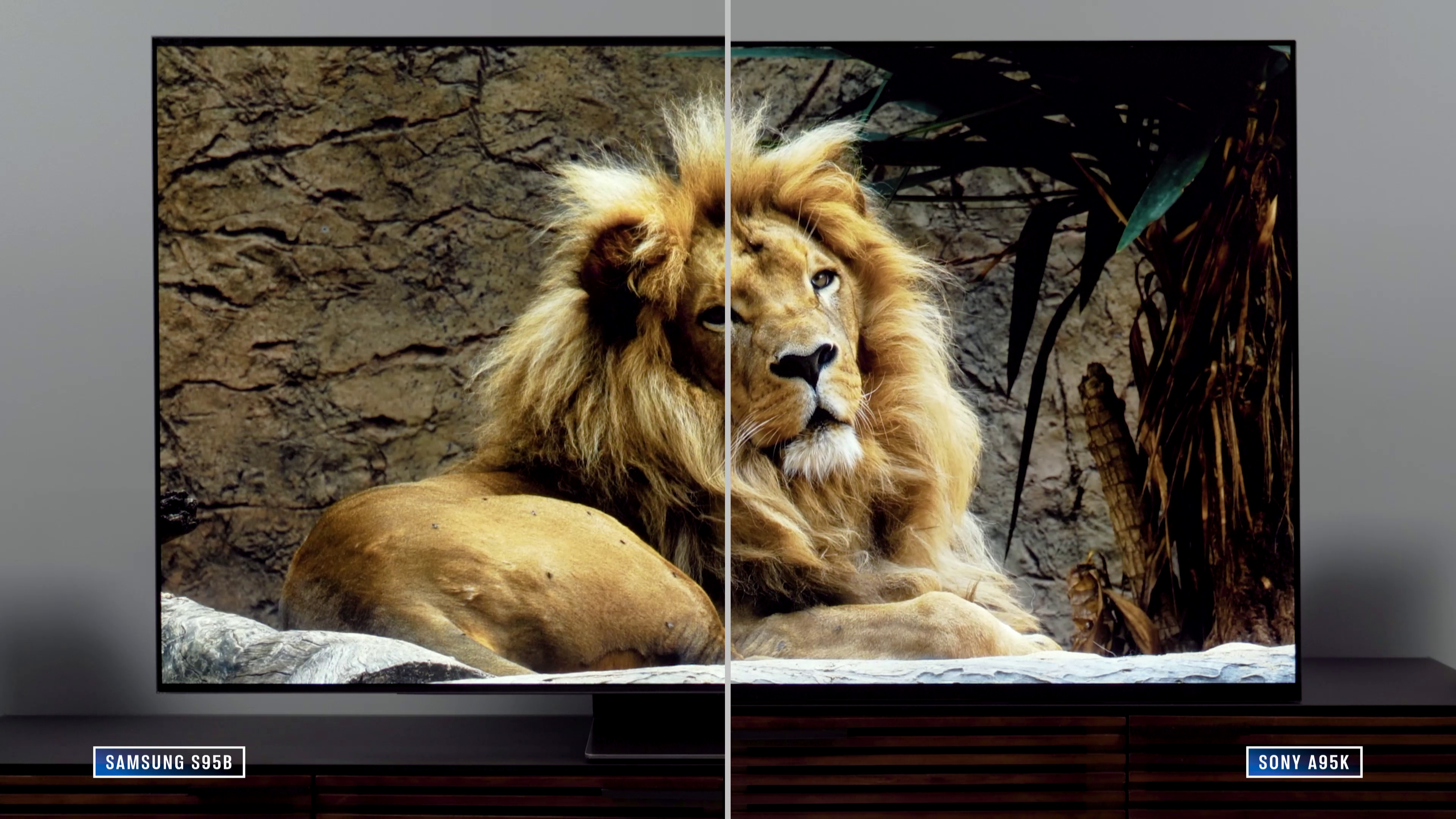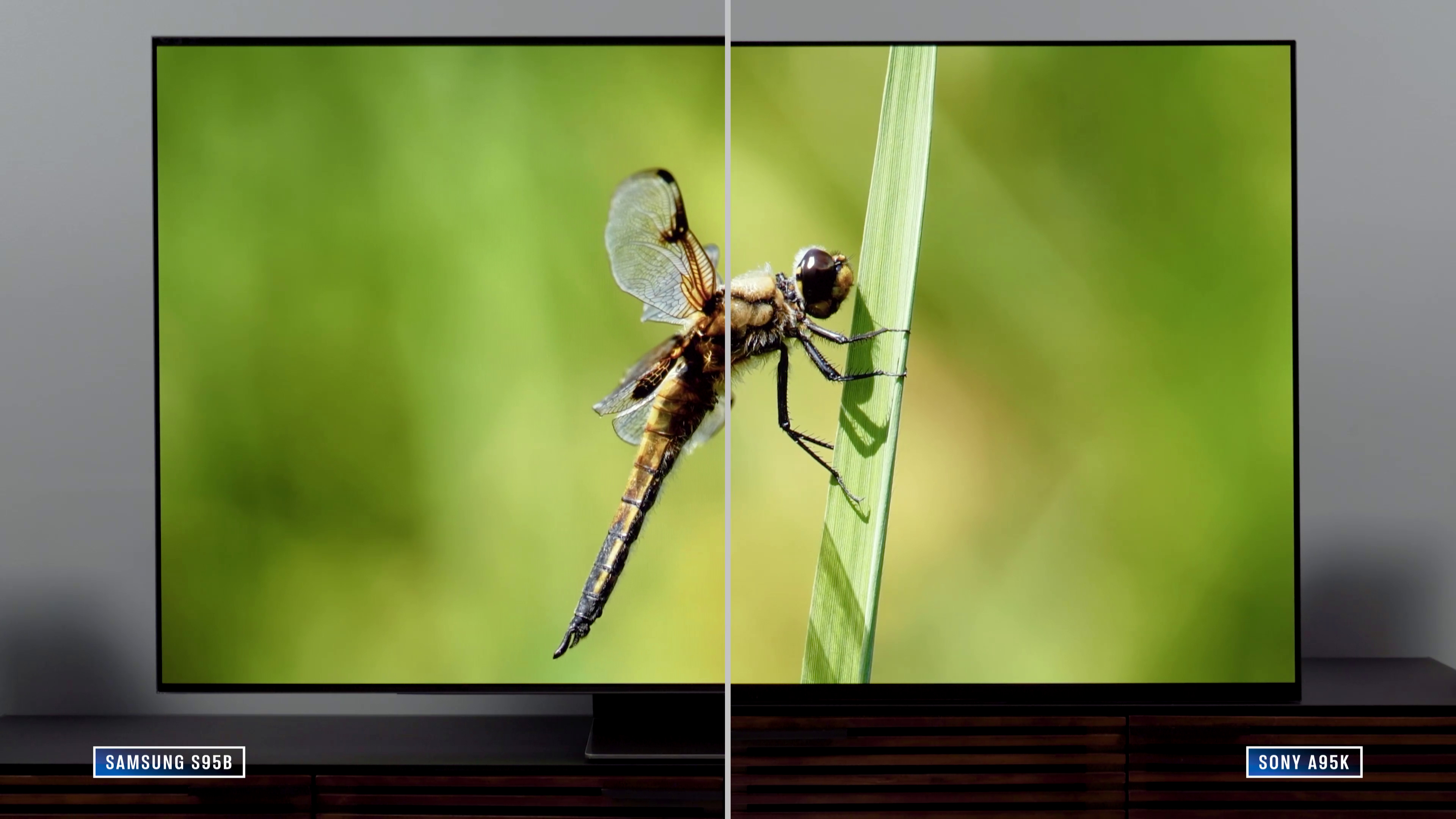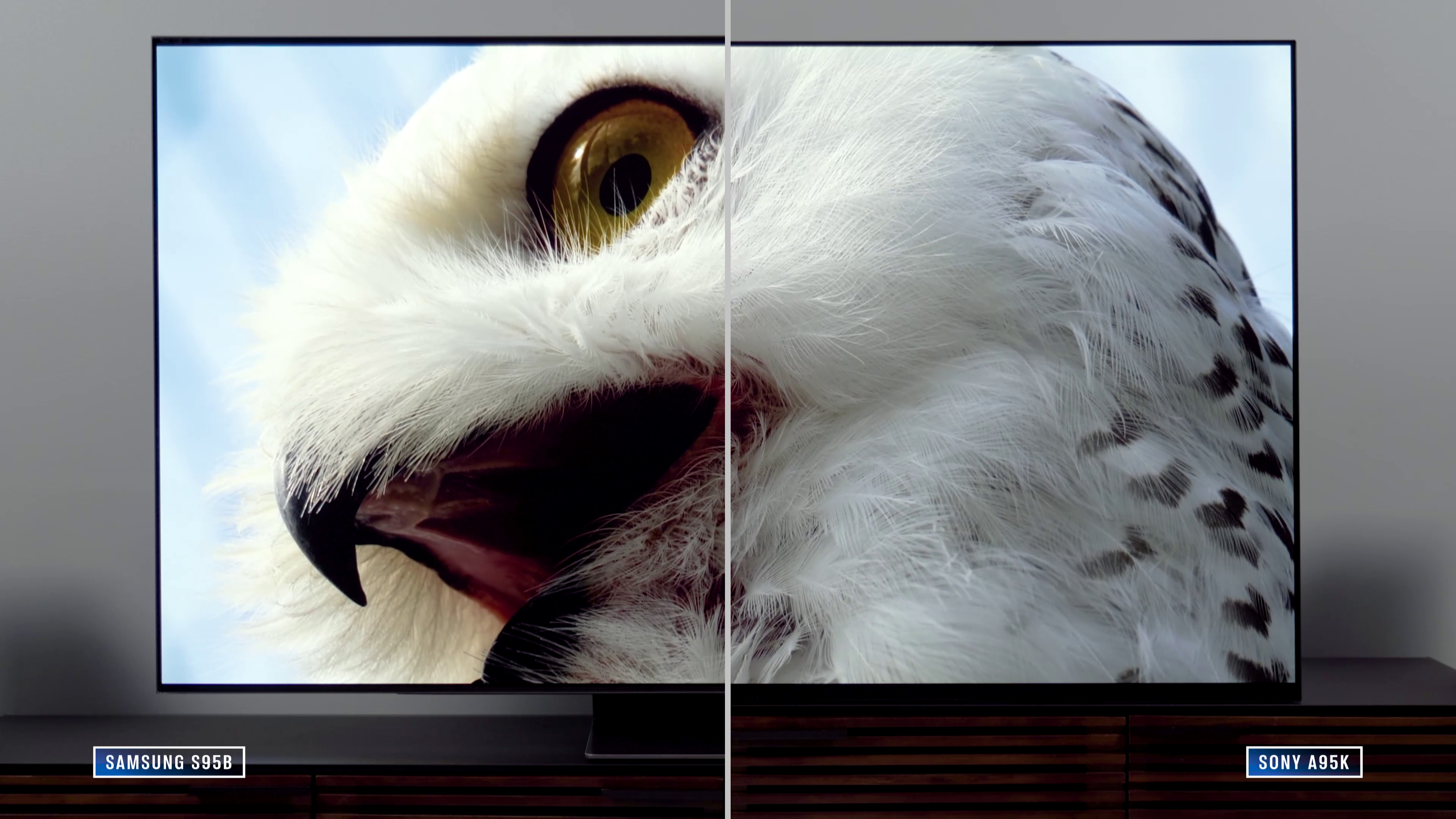There are two QD-OLED TVs you can buy in 2022 — the Samsung S95B and the Sony A95K. Both use the same new quantum dot-infused OLED panel technology, and they both put out excellent picture quality. But the similarities end there. Everything from design, to sound quality, to gaming features and the price is significantly different.
Read on to see how two of the best TVs of 2022 stack up when directly compared to each other.
Video review
Design
The most obvious difference in these TVs’ designs is the stand. This only means something if you are stand-mounting the TV. And if you are, take a look at the Samsung S95B and its central pedestal stand. It’s stable enough, allows a little room for a slim soundbar, and perhaps most important, is going to fit on just about any media stand thanks to its small footprint.
By comparison, the Sony A95K demands a fairly big media stand. The pedestal, if you want to call it that, runs the entire width of the TV and runs fairly deep behind the TV if you place the pedestal at the back. You can also have the pedestal oriented toward the front of the TV, so the TV can sit flush against a wall if you like, but depth requirements remain the same regardless.
The Sony doesn’t need to offer much in terms of cable management because it’s going to hide whatever is behind it. But the Samsung has a little room with a view. So for that TV, you’ll route cables down along the back of the pedestal and cover it up with an included cover plate.
If you’re wall-mounting, suddenly the visual differences between the two TVs are more subtle. Both of them have superthin display panels, and both have a bit of a bump-out on the back. Sony’s takes up more real estate on the back surface, but the depth of the bump-out between the two is the same. So even with the tightest of wall mounts, you’ll have a little bit of a gap between the TV’s panel and the wall. From the front, they are both attractive TVs, though I’ll point out that the Sony has a strip toward the bottom that’s a bit larger than the strip on the bottom of the Samsung.
Which do I like better? If we’re including the stand, then I prefer the Sony. While Sony’s design is less practical, I like the modernist approach. By all rights, the Samsung S95B’s design is far more practical and could be the better choice for most people.
Functional features
Remote
[/cc-placement
]I think a lot of folks overlook the fact that they interact with their remote every time they want to watch TV. Sure, you know how to you use it. But the fact that it has a huge influence on how much you enjoy interacting with your TV isn’t something at the forefront of most folks’ minds when making a purchase decision. With that in mind, here’s my take on each TV’s remote.
What I like about the Samsung remote is that you’ll never have to replace the batteries, and you probably won’t ever have to charge it, either. That’s because it can charge via solar, and it charges with radio waves already floating around in your home. No, I’m not kidding, it really does. There is a USB-C port on the bottom if you happen to live in a dark cave at the edge of civilization, but most folks won’t need it. I also like that the remote is slim – but only to a point. The slimmer it is, the easier it is to lose in the couch or chair cushions. I like that the remote is simple, but, again, only to a point. Sometimes I want a dedicated button to get straight to — let’s say the settings menu — and this remote relies a bit more on the TV’s on-screen interface to help you get to your desired destination.
I also wish the Samsung S95B’s remote was backlit. But, otherwise, it’s a great, forward-thinking remote.
I prefer the Sony remote, though. For one thing, it is backlit. For another, it’s got a few dedicated buttons that I want. Also, it feels better in the hand. And, perhaps best of all, Sony has a remote finder feature, and the little alarm built into it is plenty loud, making the remote easily recoverable even if it somehow gets buried deep within the recesses of an overstuffed couch.
Inputs
Now let’s talk HDMI inputs. The Samsung S95B supports the HDMI 2.1 bandwidth on all four ports, while the Sony has two high-bandwidth ports, one of which also is the eARC port. Think very carefully about whether this is really a big deal to you. Do you have enough gear that supports 4K 120Hz HDR VRR output to need more than two HDMI 2.1 ports? Set aside the argument that if you pay this much for a TV, then you should get all of the latest stuff, and instead consider your actual needs. If the answer is yes, you do need four HDMI 2.1 ports and that’s more important than anything else, well, then I guess you’re done with this comparison. I will, however, point out that there are A/V receivers that offer multiple HDMI 2.1 ports and can make accommodating lots of high-end gear a bit easier.
Platform
Next, I want to point to each TV’s smart TV OS platform. With the S95B, you get Samsung’s Tizen OS, and with the A95K, there’s Google TV running on Android.
I am personally a fan of Google TV. I have a Samsung TV at home, on which I use Chromecast with Google TV. Samsung’s Tizen is perfectly fine — most of the time. But for daily use, Google TV gets my vote. Having Google Assistant for voice commands works great, and I prefer Google TV’s layout. Chromecast is also built-in with Google TV, which makes sharing content from one’s mobile device just that much easier.
Otherwise, both have the apps you need, and those apps perform well on both TVs. There is some HDR-specific stuff to talk about, but that’s coming up in a moment.
Sound quality
The Sony A95K is the clear winner here, but that’s because the A95K’s onboard sound quality is just insanely good. The Samsung S95B sounds extremely good in its own right — I doubt anyone would be anything less than impressed with how it sounds. It’s just that the A95K boasts beefy subwoofer output and the fact that the screen is the speaker system. It just can’t be matched. I think it is the best-sounding TV on the market.
Both TVs offer a feature that allows them to play nicely with outboard audio systems. Samsung offers Q-Symphony Sound, which lets the TV add height and presence to the audio presentation when combined with a Samsung soundbar. Meanwhile, the Sony A95K can act as the center channel with a system like the Sony HT-A9 or with any AV receiver — just run the center channel speaker wire into the speaker terminals on the back.
All in all, for sound, it’s a win for the Sony A95K, but the Samsung S95B is no slouch.
Fun features
Let’s talk about some features that I would consider nonessentials, but nice add-ons nonetheless. The first is Samsung TV Plus, which is really just free internet TV presented as a list of channels you can flip through. The nice thing here is that you don’t have to be concerned about whether it comes from Tubi or Pluto or The Roku Channel or wherever, it’s just content you can watch. Simple.
Then there’s Samsung’s Ambient mode, which converts the TV into an art display. Some artwork is free, but there are something like 2,000 works available if you want to buy some. Also, even though it isn’t as convincing as Samsung’s The Frame, Samsung’s Ambient mode really is about just looking like art, whereas with the Sony, you get Google TV’s screensavers, which always have some sort of text at the bottom. Finally, Samsung appeals to gamers with a dedicated gaming dashboard, which is not something you get with Sony right now.
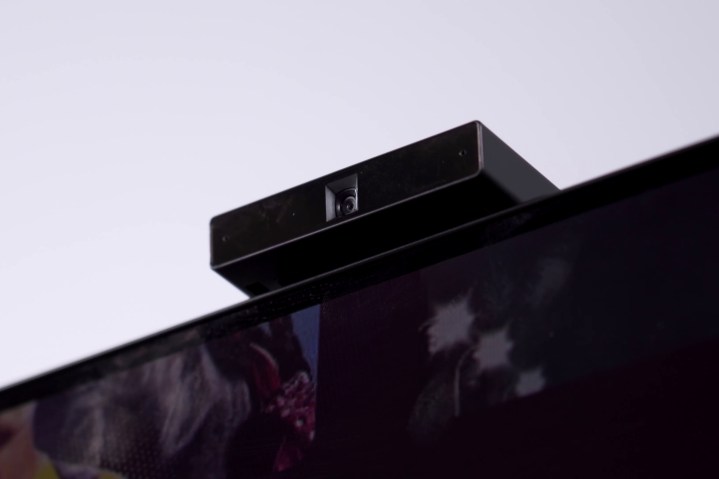
On the Sony side is Bravia Core, which offers some of the highest-fidelity video and audio available to stream. If you don’t have a 4K Blu-ray player, this is about as good as it gets for showing off your TV. It’s mostly Sony Pictures content, but there are some winners in there. Also, it’s worth pointing out that Sony is one of the last brands out there putting out 4K Blu-ray players, so if you like seamless integration, Sony has that.
Then there’s the Bravia Cam. This comes in the box with the TV, and the port for it is integrated right in the back so you don’t have to run a USB cable for it. It can tell you if you are sitting too close to the TV, act as a video camera, and optimize the picture quality in the room, presumably better than the built-in sensor you find on many TVs out there. I’ll be honest and tell you I haven’t played with this much. I’m just mentioning it in case the idea entertains you.
Picture quality
Here is where I’m going to take a different approach from other reviews. I stated at the start of this review that I think the A95K has better picture quality, but what I didn’t talk about was the razor-thin margin that exists between these two TVs.
When it comes to picture quality performance, it’s not like we’re comparing a Lexus to a Toyota. It’s more like comparing a McLaren to a Bugatti. Both are the TV equivalent of a supercar. Both offer excellent handling and acceleration — it’s just that one just edges out the other by a tiny bit in a couple of areas.
In most measurable areas, these two TVs are neck and neck. Color accuracy, color volume, off-angle performance, glare reduction, motion resolution. The only areas where these TVs seem to diverge are how they handle brightness and shadow detail. By measurements alone (and this comes down to how you measure), the Samsung appears to offer slightly brighter highlights in some cases, while it also tends to crush blacks just the tiniest bit versus the Sony. But in side-by-side comparisons, whether watching SDR or HDR10 content, the Sony appears brighter. Its HDR pops just a bit more. The subjective perceptual evaluation deviates a bit from the objective.
But there is one area in which these TVs will diverge a bit more significantly. And that’s any time it comes down to watching content in Dolby Vision versus HDR 10. Take Black Panther on Disney+, for example. It will be in Dolby Vision on the Sony because the Sony supports it, and it will be in HDR 10 on the Samsung, because it doesn’t support Dolby Vision, and the title is not yet available in HDR 10+, so that isn’t an option.
In this case, the Sony was brighter and a bit more vibrant. The APL was up a bit, and the highlights were a bit punchier. This will vary a bit depending on the content, but what I want to point out is that this is less a Samsung versus Sony performance consideration, and more an HDR 10 versus Dolby Vision consideration. With Sony, you will get Dolby Vision, and with Samsung, you will not. Whether you prefer Dolby Vision or think Dolby Vision offers a real benefit a high percentage of the time is up to you.
To be clear, this perspective is with the benefit of having the two TVs side by side so we can scrutinize. I will challenge anyone who claims to sit in front of the Samsung S95B and think they are missing out on something based on what they witness coming off the screen. It’s only with the benefit of a direct comparison that we can see any differences at all. And those differences are few and far between.
The Samsung TV in game mode is considerably brighter than the Sony in our tests. That seems to be the way Samsung likes to handle its gaming mode. Whether you prefer that look is up to you.
Burn-in and ABL
Before I get to the conclusion, I want to address the two most common questions readers submitted to a poll I ran as I prepared this comparison.
The first: What are the differences in potential burn-in? Answer: I don’t know. I’m not super concerned about either one of them burning in based on my personal use style — like, not at all. And nothing but a long-term torture test is going to offer concrete conclusions there. The Samsung isn’t inherently at higher risk than the Sony or vice versa. I think your viewing habits matter more than anything else.
Do you put ESPN (or any other sports/news channel) on every day and leave it on that channel for hours on end, never turning it off, day after day, week after week, month after month? Then I probably wouldn’t get either of these TVs. And with that, I’ll leave the burn-in thing there.

The second: What about auto brightness limiter, or ABL? Any meaningful differences there? Answer: Have a look at the video above and see for yourself. Since Samsung requires a screen-saver to be triggered within the API for its onboard apps (I can’t figure out how to defeat it), any image on which you pause is going to be swapped for a screen saver before noticeable ABL kicks in. On the Sony A95K, ABL can be witnessed over the stretch of over three minutes or so if you pause the image long enough.
I don’t know about you, but I don’t watch content on pause. I don’t want the same bright image on full blast for more than 5 or 10 seconds, much less a minute or more. Certainly not for as long as it’s going to take me just to type out this paragraph. What I’m getting at is this: I did not experience any meaningful degradation in viewing brightness while watching these two TVs side by side. Not for real content. And as I mentioned before, for SDR and HDR 10, the brightness was neck and neck. ABL was never a factor for real viewing.
Price is a factor, now more than ever
Now we come to the inevitable mention of price. Earlier, I remarked that in terms of performance, comparing these TVs was analogous to comparing a Bugatti and a McClaren. But if I were to continue brutalizing such an analogy, I would have to say that when it comes to price, it is like we are comparing a Lexus and a Toyota. One begs a premium. And it delivers a bit for that premium. The question is whether that premium is worth it for you.
I suspect that for most folks, the Samsung S95B is the far better choice. It delivers such an incredible experience for significantly less than the Sony A95K. We could be talking about $1,500 worth of difference. I can’t justify that kind of price difference for the Sony A95K. Is it the best-performing TV of 2022? Absolutely. I stand behind that. Is it going to be my top recommendation? No. And that’s because I can’t look someone in the eyes and tell them the significant added expense is worth it.
If cost was no object for me, I’d pick up the Sony all day every day. No question. But in this particular battle, I have to call a clear winner, and for me — and I suspect for most people — the Samsung S95B is the smarter pick. And in the end, it’s all about the money.
